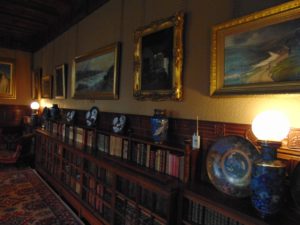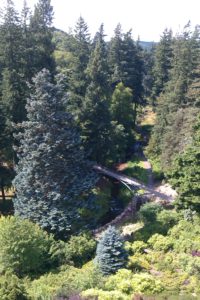As the project draws to a close we are polishing up our outputs ready for final delivery. One of the outputs which we are producing for Cragside is a set of three bespoke educational animations to help volunteers to explain Cragside’s electrical heritage to visitors. The animations have been produced by our undergraduate animation intern, Alex, and will be used to demonstrate how Lord Armstrong employed and experimented with electricity at Cragside, and how he used the surrounding landscape to generate hydroelectricity to light his house – the first private house to do so.
Of the three animations, one illustrates how the house’s iconic cloisonné lamps were originally electrified in December 1880. This was a little unusual and can be hard to explain. The only source we have is a letter Armstrong wrote to the Engineer in January 1881, in which he explained that the lamps could be switched off or on by picking them up and putting them down again. As this was a very experimental period in the history of electrification, before switches were readily available, this was accomplished using a dish of mercury.
A wire ran down from the bulb at the top of the vase, and dipped into the mercury. The dish was set in the centre of a metal disc connected to two wires: one carrying current to the bulb, and the other being the return wire for the circuit. The metal body of the vase itself – copper – served to return the current back to the return wire. Thus, when the vase was placed on the metal disc and the wire from the bulb dipped into the dish of mercury the circuit was completed and the bulb was lit. Lifting the vase from the metal disc would have switched the light off. As the cloisonne vases were coated entirely in enamel it is likely that this would have provided sufficient insulation for the vases to have been moved by hand. The animation provides volunteers with a very visual way of explaining this process.
[youtube https://www.youtube.com/watch?v=tq2G4JIWbEw]
The second animation is of the arc light which used to hang in the Picture Gallery at Cragside between c1878 and 1880 – when Armstrong and Joseph Swan installed Swan’s bulbs. This can no longer be seen at the property, but the animation gives an idea of how it worked – including the noise of operating it. The animation demonstrates how early arc lights comprised two vertical rods of carbon in an electrical circuit, separated by a gap. The current jumped across the gap, creating a bright arc. The distance between the two rods needed to be carefully regulated: if it was too small, the arc would correspondingly be too small to generate sufficient light. If the gap was too wide, the current would not be able to arc across it. However, as the rods burned away with use it was important to have a mechanism which automatically moved the rods to keep the gap the same size as the rods became shorter. Arc lights were more commonly used for outdoor lighting, and not many people experimented with bringing them inside to illuminate their rooms. This, alongside the cloisonne animation, therefore helps to highlight Armstrong’s willingness to experiment and innovate.
[youtube https://www.youtube.com/watch?v=O83e71MJ2H8]
The final animation shows how the hydroelectric system at Cragside worked, with water running down the hill from a man-made lake at the top, and operating a dynamo in the Power House – a separate building containing the dynamos and the batteries, which stored excess electrical charge for periods of high demand. When more current was required to light more rooms, the butler used a telephone to ring down to the Power House to request more power. The animation shows this simply as the movement of a lever: this operation might have been performed by switching resistance coils out of the circuit (thus decreasing the resistance and effectively making more current available for the lights in the house), or by switching the batteries into the circuit. After this happens in the animation we see more lights coming on in the house, represented by the cloisonné lamp in the Library, until it is entirely illuminated.
[youtube https://www.youtube.com/watch?v=zyZHEZtoQ_Y]
Volunteers will have these animations on tablets, and will be able to use them as explanatory tools when discussing the history of electricity at the property with visitors. The role of volunteers in providing explanatory interpretative content is very important at Cragside, as at many other country houses. When discussing how the project could deliver outputs which would best benefit Cragside, representatives of the house were keen to produce something which emphasised the role of volunteers, rather than written interpretative content such as panels or trails.
When drawing up the storyboards for each of the three animations, therefore, Alex and I consulted with Cragside staff in order ensure that the content was accurate and suitable for this purpose: the animations needed to be short – concise and focused without distracting elements – and visual, without relying on text. The animations will be in use at Cragside in the next month, and will also be available to view online.
[Edit, 4/7/16 – This post now contains final versions of all three of the animations. Please also see our Downloads page for further supporting information on these animations.]









